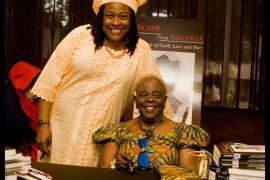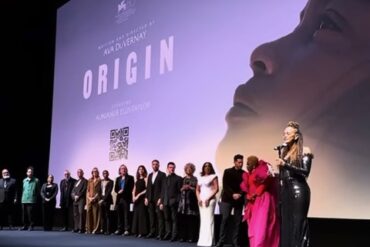Ida B. Wells, born July 16, 1862, and died March 25, 1931, was a civil rights activist, journalist, and suffragist. She was renowned for her heroic fight for freedom, justice, and equality for Black people and advocating for women’s right to vote.
She became a force for change as she penned articles, spoke out, and exposed the truth about lynching during the late nineteenth century and early 20th century. This reaped consequences. In a short period of time, her friends were killed, her printing company was destroyed, and her life was threatened. These tragic events resulted in her locating to Chicago from the South. She moved to 3624 S. King Drive in the heart of Bronzeville and made Chicago her home for 35 years. Undeterred, she continued her crusade for freedom, justice, and equality.
Ida B. Wells was one of the founders of the NAACP in 1909 and worked with Jane Addams on a mission to thwart the movement toward segregated public schools. In 1913, she founded the Alpha Suffrage Club as a vehicle for giving Black women a voice, a presence, and a purpose in the suffrage movement. This mobilization was a direct result of Black women being denied admission into national suffrage organizations. The Ida B. Wells-founded Alpha Suffrage Club evolved into one of the most potent in Illinois.
Because of her impact in the pantheon of history, Ida B. Wells is an icon. Her passion, resilience, and singular focus on freedom, justice, and equality left an indelible mark on all she advocated for and on all she touched. In tribute to her, Chicago’s Ida B. Wells Homes were erected and her name memorialized.

Michelle Duster, Ida B. Wells’s great-granddaughter, was born 32 years after her great-grandmother’s death in 1931. Growing up, she was powerfully aware of Ida B. Wells’ fame and stature. Reverently respectful of her family tree, she speaks with pride of her lineage: Ida B. Wells was her father’s grandmother and Michelle’s grandmother’s mother. Ida had four children. Her youngest daughter, Alfreda Duster, her grandmother, had five children and her middle child, Donald, was Michelle’s father.
Michelle’s education reflects her pedigree: She attended Dartmouth College, where she earned her undergraduate degree in Psychology. She received a master’s degree in Media Studies from The New School – A University in New York City. She also took graduate-level classes in Film and Video at Columbia College in Chicago and mastered the mechanics of shaping narratives and images as a vehicle for telling stories. This is one of her passions. Duster’s ultimate goal is to promote and expose the wide variety of Black experiences and tell their multidimensional stories since, she says, “There’s a great interest in marginalizing our history.”
Inspired by her great grandmother, Michelle resolved to shine a light on her life and legacy. This mission is captured in her book, Ida B. the Queen: The Extraordinary Life and Legacy of Ida B. Wells. (Simon & Schuster.)
It is also dramatically captured in a sculpture commissioned by the Ida B. Wells Commemorative Art Committee, a subcommittee of the Oakwood Shores Working Group. It will be a permanent monument in Chicago’s Bronzeville neighborhood, at 37th and Langley, where the Ida B. Wells Homes once stood. The artwork will be an important donation to Chicago’s public art collection as the second Chicago tribute to a Black woman since the Gwendolyn Brooks bust was installed in 2018. More importantly, it is the first monument in the City of Chicago to commemorate an African American woman. This powerful and soaring sculpture, Light of Truth: Ida B. Wells Monument by the legendary Richard Hunt, was unveiled at a dedication on June 30. It will be an enduring tribute to Ida B. Wells.
Recently N’DIGO talked to great-granddaughter Michelle Duster. She chronicled the journey and her mission. She also shared her reflections of her great-grandmother, Ida B. Wells.
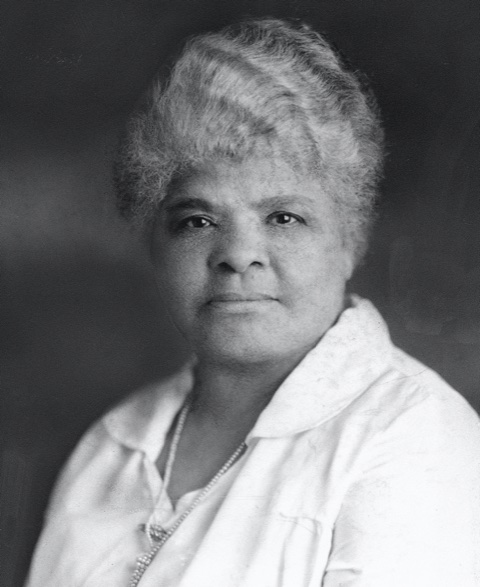
Melody M. Dowell for N’DIGO: Let’s imagine that your great-grandmother was transported to this present moment. With the resurrection of voter suppression laws in many states that some are characterizing as Jim Crow 2.0 … and with the Supreme Court upholding Arizona’s voter restrictions, what would she say or do?
Michelle Duster: I’m sure she would be disappointed. Imagine. Ninety years after she died, and after spending 50 years fighting for equality, a century and a half later, her great, great, great-grandchildren are fighting for the same rights she was fighting for. Voting rights. Police brutality. Excessive force. The reality of being Black in America is disheartening. On the other hand, my great-grandmother would be happy to see Kamala Harris as Vice President and would be pleased that the 117th Congress has over 25% women. It’s a weird mixture of progress and regress.
Many books have been written about Ida B. Wells, documentaries have been produced and there are thousands upon thousands of Google entries about her. But for this one-on-one, please, tell us – briefly – who she is through your prism. And, how wonderful is it to see the Monument come to life.
She’s my great-grandmother. This monument is a huge tribute to a direct ancestor who was a national figure – a force fighting against lynching, for equality, and justice long before we had the term Black Lives Matter. There was mob rule and state-sanctioned violence during her time. This monument represents the recognition by the City of Chicago, State of Illinois, and even this country for a lifetime worth of her work.
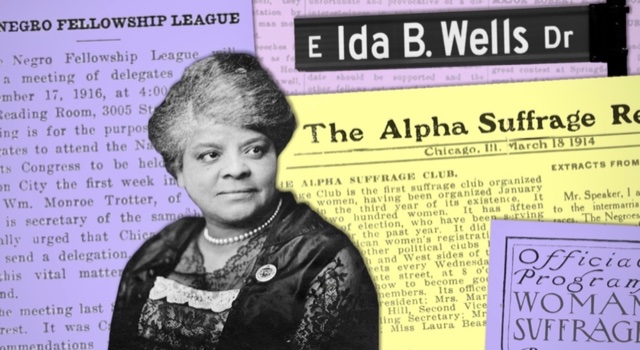
When was the first time you ‘got’ what a historic and iconic figure your great-grandmother was?
I grew up knowing that my great-grandmother was famous. I didn’t realize the level of violence and the danger she faced and the magnitude of what she actually achieved. When she was 22, she sued the Chesapeake and Southwestern Railroad. That’s what made me realize what an extraordinary woman she was. When I was 22, I was partying and realized: “I’m the same age now as when she took on and sued a whole railroad. And here I am going to a party.” That was a moment of clarity.
As a descendant of such a giant, and with whom you share DNA, do you see any parallels between your lives?
My great grandmother made history and I’m making sure that people don’t forget history and that our history doesn’t get erased. I want to make sure that our stories, experiences and perspectives are told in a complete and realistic way. We were both committed to countering and dismantling false narratives – like the notion that we are all gang members. I’m trying to uplift the positives of we as a people and who we really, really are.
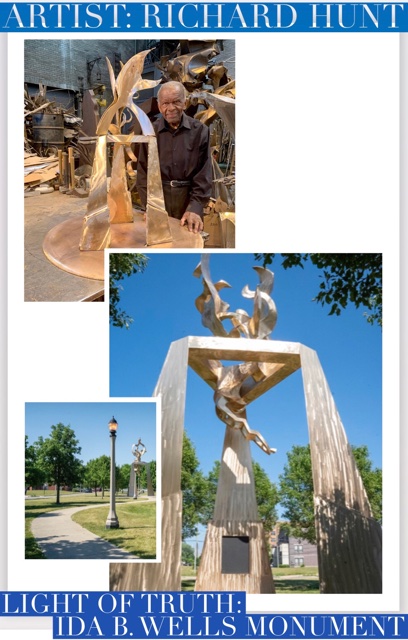
What was the series of events – or even the moment – that led you to begin the journey that culminated in a Monument in her memory?
What prompted me to become inserted in what has become “The Monument” was when the City began to demolish the Ida B. Wells Homes in 2008. I was outraged because Ida B. Wells was not a building…she was a woman who needs to still be honored. I wrote Mayor Daley demanding to know, “What is the City going to do to remember Ida the woman?” We were invited by the Mayor to attend a Committee meeting formed by the previous residents to represent our family in creating something to remember Ida. I was asked to join the Committee. That was helpful to me because it wasn’t a family request. Nathan Mason who was on the Committee and works for the City was part of this project from beginning to end.
The Committee considered different ways to honor her and decided that a monument was the best way to capture her essence because she was multidimensional and complicated. We wanted something abstract so everyone could have their individual experience with the Monument. We approached Richard Hunt and he agreed to be the sculptor.
How much time elapsed between conception to the dedication of Light of Truth: Ida B. Wells Monument?
We first approached Richard Hunt in 2010 and raised the final $300,000 in 2018. We had our first kickoff fundraising in 2011. He waited seven years for us to raise the money and he put us in his queue.
What were the challenges the Ida B. Wells Commemorative Art Committee faced in bringing the Monument to life?
Raising the money. We had several fundraisers and a mail-in campaign. I must give credit to journalist Nikole Hannah-Jones and activist Mariame Kaba who both became interested in the project. By 2018 less than 1/3 of the money had been raised. Through their networks including their twitter followers, the fundraising was ramped up. Between the three of us tag-teaming, all of the needed money needed was raised in four months.
From an emotional standpoint, there were other challenges. My father passed away in 2013 and other Committee members died early on and we were shaken up. I was one of the co-chairs of the Committee and after my father died, I went through a rough period. I just couldn’t work on the Committee during that time.
And the rewards?
Seeing the completion of the work. It’s very emotional to see this piece that Richard Hunt created…its size and majesty. It is a fitting tribute to who Ida was. It is a gift to the City of Chicago, a strong source of pride for the Bronzeville community, and an emblem of pride and admiration to former residents of Ida B. Wells Homes.

Pivoting a bit, how does it feel to drive on Ida B. Wells Drive?
It’s incredible to see the signage and her name positioned so prominently on I-94 and 290. It’s very fitting given the sacrifice she made fighting for the idea of what America is supposed to be. If people don’t know who she was they can look her up right away. It’s important for this country to recognize Black Women who are so underrepresented and whose stories are so under told. It says something about a nation where only one street is named after a woman who gave to this country. I really like that they used her entire name: The Ida B. Wells Drive and not just Wells Drive or Street. There are very few streets that bear a person’s full name.
This monument is both gasp-worthy and captivating. Its image stays with you long after you’ve viewed it. Richard Hunt deserves kudos for this creation. But, looking at its imagery what are the parallels between this creation and her life?
The three pillars represent Ida B. Wells as Suffragist, Journalist and Civil Rights Advocate. The bottom of the Monument has a very strong presence and is wide and broad. That is symbolic of who she is. The top is soaring and represents the light. Everybody can interpret the Monument the way they want to. It is open for interpretation and discussion. I see it as a launching point for dialogue. Seeing the completion of the work is very emotional.…the size and majesty. It is a fitting tribute to who Ida was. It is a gift to the City of Chicago, a strong source of pride for the Bronzeville community, and an emblem of pride and admiration to former residents of the Ida B. Wells Homes. It is also a tourist destination all can admire.
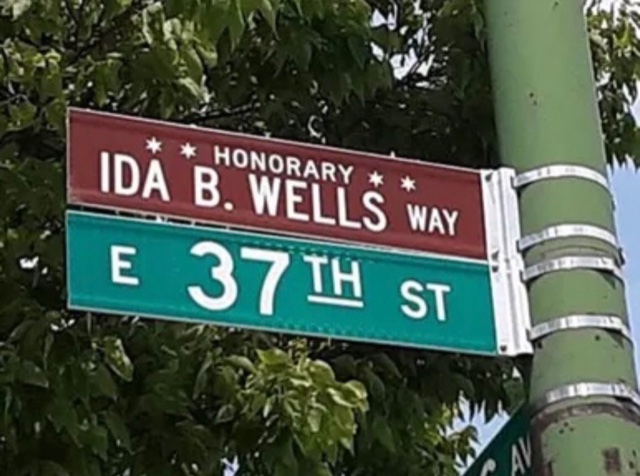
Are there any other highlights you can share?
There is a winding walking path along the median strip between 37th and 39th Street and Langley. There will be smaller informational pieces making this an educational experience that captures the true essence of the community. It will be more inclusive of other people – not just Ida. Through the help of Alderman Sophia King, we were able to secure a historical marker at 37th and King Drive, where the Ida B. Wells Homes once stood. We want people to remember the Homes were there.
When people look at the Monument, what message do you want them to take away from it?
One of my hopes is that people will use that space as a location where they can get a sense of power and gain strength. I envision people taking yoga classes near the Monument and having poetry readings. They should pay homage to my great-grandmother but re-center themselves and use that space as a sanctuary and source of rejuvenation.
Thank you, Ms. Duster.
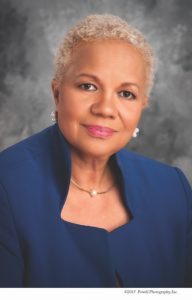
Melody M. McDowell is a seasoned writer and veteran publicist. In addition to N’Digo, she’s penned articles for Black Enterprise, Quirk’s Marketing Research Review, and Crain’s Chicago Business. Her Public Relations firm, MELODY’service, celebrates 40 years in business on August 1. Its client roster includes the Museum of Science and Industry, the Coca-Cola Bottling Company of Chicago, and Neighborhood Housing Services of Chicago. She once served as the personal publicist for Dr. Mae Jemison, the first woman of color to launch into space. She has received many honors, including the Media Cornerstone Award from the U.S. Department of Commerce – Minority Business Development Agency. She was also hailed as one of Black Chicago’s “Ten Most Interesting People” by Who’s Who in Black Chicago. However, one of her proudest and most stunning achievements was beating out experienced white male speakers during her first time competing in the challenging Evaluation Contest for Toastmasters. Melody is a proud member of Alpha Kappa Alpha Sorority and served as its publicist for eight years, including in 2008, its Centennial year. Melody lives in Markham, Illinois — a city she has grown to love after transplanting from Chicago. Melody also loves cats.



